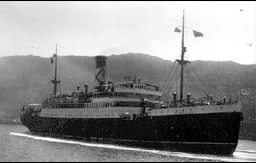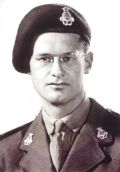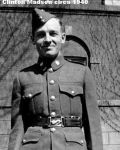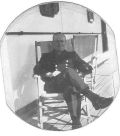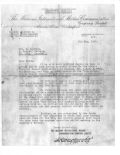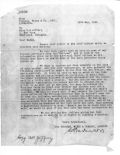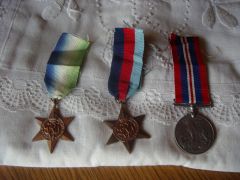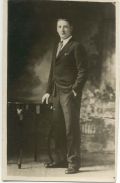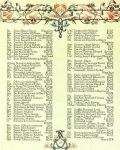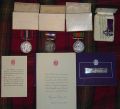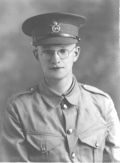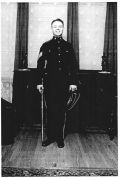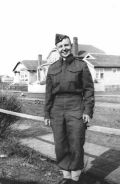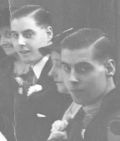Lt. Cdr. Robert A.F. Nicholl-Caddell
Royal Navy (Temp) – HMS Revenge
< BACK TO REMEMBERING
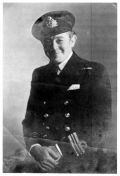
Click for a larger version
Lt. Cdr. Robert Nicholl-Cadell was born in 1900 in the Assam, India where his father Bernard was District Commissioner. Robert’s grandfather Iltyd Nicholl was a captain in the Navy. In 1915 Robert’s father died and his mother Winifred returned with Robert and his 6 sisters to England. In 1920 Robert inherited a substantial house in Ireland called Harbourstown from his grandmother Cecilia Nicholl (nee Jerningham, the daughter of Admiral Jerningham). Robert married young and lead a fun-loving life – riding horses up and down stairs inside the large house. Robert had three children, Bernard and two girls. The girls never married. Robert’s grandson now lives in Australia. The big house in Ireland was pulled down in 1941 presumably following Robert’s death. Clearly Robert was a colourful character. I understand he was on the Nerissa being transported home because of ill health. My mother and aunts told me of how when on leave from the convoys he would scream out in fear during the night. One can only bow one’s head in deep and silent respect for such men and give thanks for their courage and fortitude.
Peter Cockerill, nephew.
Biographical memories of ROBERT ARTHUR FRANCIS NICHOLL-CADDELL
(b../…/1900, d. 30/04/1941) written for his grandson Brendan by Robert’s sister, Joan Huffer.
He had his mother’s hair – thick, with a tendency to curl – in colour, a titian red-gold which was inherited also by my youngest sister, Dorothy (Peter’s mother). He had a very infectious laugh, and a smile that wrinkled his eyes to slits. He was a “Romantique”, and “idealist” to the end, in spite of the stark sides of life he so often, and so early saw. He was very impatient with mundane life, and despised mediocrity or “meanness”. He was fired at once by “great causes” which made him admire communism (we didn’t know Stalin as he was, in those days) and join a boat under a commander known as “Potato Jones” which smuggled cargoes of potatoes into Spain for the Republicans, who lacked food.
Robert was ten years older than me, but treated me as an equal – we had terrific discussions together, and I loved him very much.
He had a very unstable life from the beginning when he was shunted from India, where he was born, to England where he stayed with “Aunt Lina” in Wimbledon. When he was twelve or thirteen (?) he was sent to the Naval College at Dartmouth. At sixteen (14, if he was born in 1900!) the 1914-1918 war broke out. At that age the “midshipman”, which Robert had become, was sent for the first time to a battleship to continue his training and mount in “grade”. In Robert’s case it was to go straight into “active service” and his ship took part in some of the great naval battles of the time, including Jutland.
At the end of the war, he went to University (I forget whether Oxford or Cambridge) and won a degree in English Literature. He made friends with various writers and artists – H.G. Wells, Ford Maddox and etc… He himself was very “gifted” – he could write, and draw well. I believe some of his charcoal drawings were accepted by the Academy in Dublin.
I think he must have met Paulina when he visited Great Aunt Aggie at Harbourstown, but I was still at school then and it is all very vague for me. Anyhow, they met…. Both enjoyed life and friends and joyous company with laughing and lots of drinking ! Paulina’s mother, who held court in Dublin and liked to have all promising and gifted young men at her feet, was furious that Robert had fallen for Paulina, and when they decided to marry, turned her out of the house. Robert brought her over to England to “Mudgie” (my mother), in Lyme Regis where they stayed with, or near her in “Woodmead Road”. After their marriage they went to Ireland to live at Harbourstown. There, Diana was born. She was mentally handicapped – at 13 she was as a 7-year-old. Dick French (my eldest sister Agnes’ husband) who was her guardian, got her into a very good “Home for backward children” run by a Miss Binnie who loved her, and whom she loved. Diana, as she grew up, helped Miss Binnie with the house and the other children. Mudgie often went to see her, and so did my elder sisters – I was at school still and never did. Diana died in her teens { ?? Don ‘t know about this, as I remember receiving Christmas cards from her when I was at boarding school in the late 1950s and early 1960s}. Then your father was born, and after him another little boy called Iltyd – He was “Mongolian” – really a very beautiful child, I was told – He died as a baby. Robert was always coming and going from and to different places and countries to find work – I can’t remember why they left living in Ireland, and why Robert went out to India and met Marcia, and what Paulina was doing. By the way, someone asked if I saw Marcia, or knew what happened to her. I met her once in Paris after the 1940 war. She was still very lovely. We spent an afternoon together and then she went on somewhere else. I heard she had married a brilliant cancer specialist – a Frenchman – but after that I don’t know what happened.
Robert never looked after the land that belonged to Harbourstown, the farm lands were left uncultivated, the woods over-grown, etc. In such cases after some time the government requisitioned the property and the house was pulled down. Robert himself was on the Royal Naval Reserve, and when the last War broke out, he was called up to do active service. Being still young, he was one of a lot (about 30) of other men with wartime experience yet not too old to fight at sea again. He was sent to an ultra-secret base in Northern Ireland to study “radar” which was then unknown. After that he was put in command of a ship, “Lord Essenden” at the head of a flotilla of Scottish trawlers, which were armed with anti-submarine devices and cannons and whose job was to protect the route from Russia to England followed by boats bringing food to the besieged island.
The work and the climate were terrible. Robert was on the bridge without rest for a week on end, when they went into port for one day and night to take on provisions. The climate in those frozen northern seas was deadly and finally attacked his heart. He was sent to Canada (I don’t know why) to be de-mobilised and then on a ship for England. This ship was torpedoed and sunk. Robert, in his condition, had no chance in the icy waters and must have died instantly.
Some time after this, my mother had a visit from one of the survivors, a man who had made friends with Robert during the voyage. He told my mother “I wanted you to know that my last sight of Robert was from the life boat which had picked up my wife and myself. He was still on the ship helping to put the life boats to sea. He leaned over the rails to shout to me ‘Is your wife safely with you ?’. I never saw him again but I wanted you to know this.”
Robert’s name is on the Naval War Memorial in Portsmouth and on the War Memorial in Beaconsfield, where we lived at that time.
NB The insertions in italics are added by Caroline Morgan-Smith, Joan’s niece, who transcribed her hand-written notes.
October 2004
Notes:
On the Court of Inquiry – Department of National Defence Naval Service, it shows Lt. Cdr. Nicholl-Cadell under Naval Officers on Board and it also mentions that he was seen dining with Pay Cdr. Nixon prior to 1930 hours. They were detailed to Lifeboat #1 but neither made it to the lifeboat.
With reference to the comment made by Joan that one of the survivors paid her mother a visit after the war, I think this was Major Robert Stuart-French. There were only two men with wives on the Nerissa, Joseph Lomas, a civilian, and Major Robert Stuart-French. Joseph Lomas and his whole family were lost and also Joy Stuart-French, Robert’s wife. Major Stuart-French shows on the Roll of Officers Returning from Italy February 23, 1944. He was in the 11th Hussars.
Family Contacts:
Peter Cockerill, nephew of Lt. Cdr. Robert Nicholl-Caddell.
Caroline Morgan-Smith, niece of Joan Huffer.
